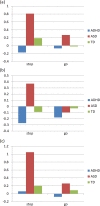ADHD and ASD: distinct brain patterns of inhibition-related activation?
- PMID: 32066671
- PMCID: PMC7026183
- DOI: 10.1038/s41398-020-0707-z
ADHD and ASD: distinct brain patterns of inhibition-related activation?
Abstract
Attention-deficit/hyperactivity (ADHD) and autism spectrum (ASD) disorders often co-occur. In both cases, response inhibition deficits and inhibition-related atypical brain activation have been reported, although less consistently in ASD. Research exploring the overlap/distinctiveness between ADHD and ASD has significantly increased in recent years, but direct comparison of the inhibition-related neuronal correlates between these disorders are scarce in the literature. This study aimed at disentangling the shared and specific inhibitory brain dysfunctions in ASD and ADHD. Using functional magnetic resonance imaging (fMRI), brain activity was compared between children with ADHD, ASD and typically developing (TD) children aged 8-12 years during an inhibition stop-signal task, using stringent inclusion criteria. At the behavioural level, only children with ADHD exhibited inhibition deficits when compared with the TD group. Distinct patterns of brain activity were observed during successful inhibition. In children with ADHD, motor inhibition was associated with right inferior parietal activation, whereas right frontal regions were activated in children with ASD. Between-group comparisons disclosed higher middle frontal activation in the ASD group compared with the ADHD and the TD groups. Our results evidence different patterns of activation during inhibition in these two disorders, recruiting different regions of the fronto-parietal network associated to inhibition. Besides brain activity differences, behavioural inhibition deficits found only in children with ADHD further suggest that reactive inhibition is one of the core deficits in ADHD, but not in ASD. Our findings provide further evidence contributing to disentangle the shared and specific inhibitory dysfunctions in ASD and ADHD.
Conflict of interest statement
The authors declare that they have no conflict of interest.
Figures



References
-
- Diagnostic and statistical manual of mental disorders. 5th edn (American Psychiatric Association, Arlington, VA, 2013).
-
- Antshel, K. & Russo, N. Autism spectrum disorders and ADHD: overlapping phenomenology, diagnostic issues, and treatment considerations. Curr Psychiatry Rep.21, 34 (2019). - PubMed

